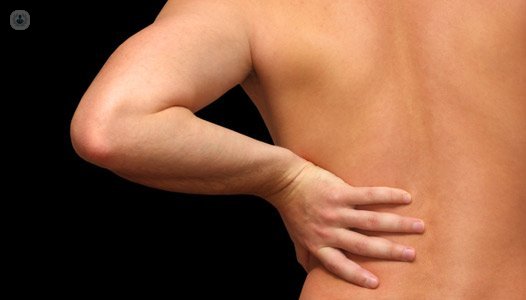What is spinal stenosis?
Written by:The lumbar stenosis is a narrowing of the spinal canal at the expense of bone proliferation that compresses nerve structures containing. Specialists in neurosurgery claim that this causes damage to the spinal cord and spinal nerves.
There are two types of lumbar stenosis:
- Relatively rare primary lumbar stenosis or congenital,
- Secondary or acquired lumbar stenosis, much more frequent
 Secondary lumbar stenosis corresponds to the final stage of osteo-arthritic degeneration present in adults of a certain age, over 60 years. At that time all degenerative, traumatic processes, mechanical application, etc., sustained throughout life accumulate patient.
Secondary lumbar stenosis corresponds to the final stage of osteo-arthritic degeneration present in adults of a certain age, over 60 years. At that time all degenerative, traumatic processes, mechanical application, etc., sustained throughout life accumulate patient.
Symptoms of lumbar stenosis
The symptoms that people suffering from lumbar stenosis are characterized by the presence of persistent back pain or not, often characterized by a consistent phenomenon in the occurrence of low back pain, prick buttocks or legs during walking, the after a certain distance and gives the rest. It is known as intermittent claudication and incapacitates the patient to walk, sometimes a few meters. In some other cases, claudication may be sensitive, appearing tingling and numbness in the legs areas.
In advanced cases, it may be accompanied by urinary incontinence and impotence in men.
It is the most common cause of limitation of gait in older, although we must differentiate claudication of origin vascular insufficiency in the legs.
Lumbar stenosis: diagnosis
The diagnosis is made after careful examination and testing imaging: MRI or CT. One of the difficulties in the diagnosis of lumbar stenosis lies in the fact that the signs and symptoms only appear during the march and disappear at rest.
Treatment for lumbar stenosis
The treatment is surgical when indicated, that is when the symptoms or pain are significant enough to alter the quality of life.
This type of surgery involves recalibration microlimados channel through the bone of the vertebrae that have increased in size, effectively decompressing the spinal and spinal nerves. Incorporating small staples between the vertebrae, increases and maintains the new caliber obtained and allows patients to relieve their ailments.
Since most of the patients are elderly, surgery is designed and adapted to the fragility of these patients and minimally invasive. It is done through a small incision through extreme microsurgery, carried out under epidural anesthesia and a stay of two nights at the hsopital, no post-operative pain, allowing immediate ambulation after surgery, which reduces the risk of complications.
85% of patients cured or improved significantly after surgery and complications are rare, no operative despite the age of the patients mortality.
Edited by Noelia García Pino


